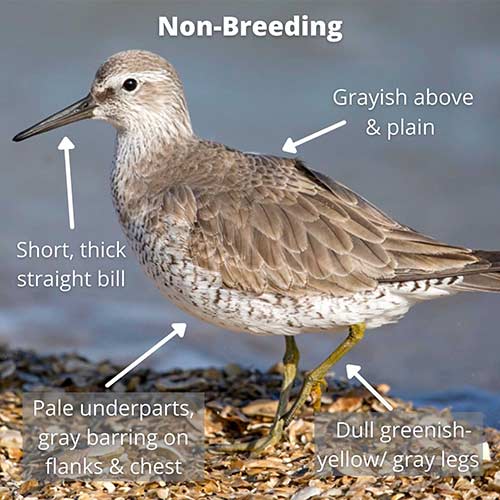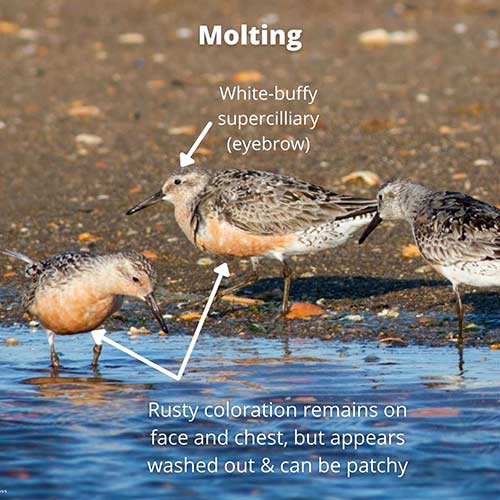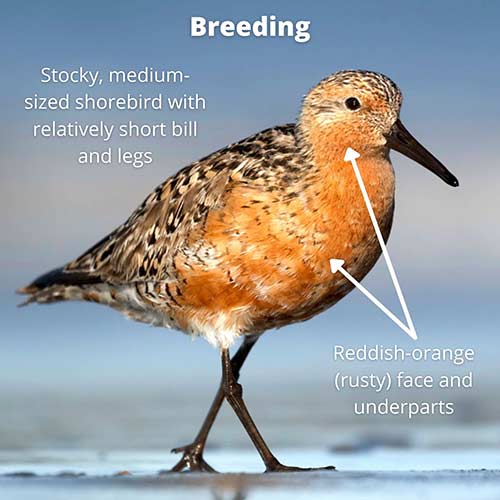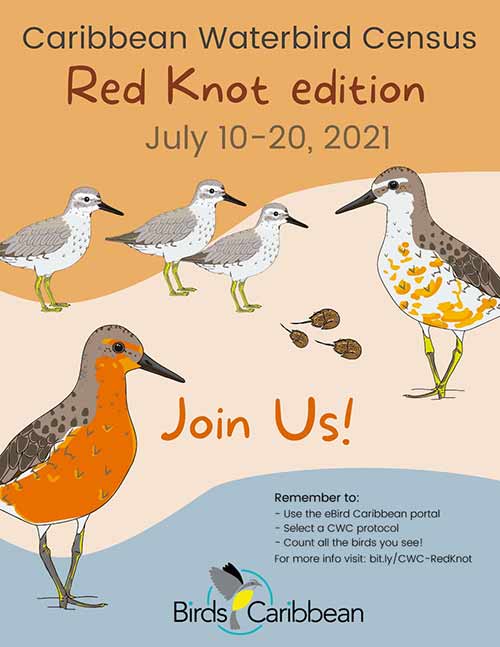The Mystery of the Missing Red Knots
Where have all the Red Knots gone?
Posted July 5, 2021
The North American Red Knots are not where they are expected to be–where did they go?
Red Knots have become the poster birds of shorebird conservation efforts.
These birds are known for their exceptional long-distance migrations, which can be as long as 9,300 miles (15,000 kilometers) on the Atlantic Flyway. A small population of Red Knots will even spend the winter on Bonaire.
But something strange has occurred this year–counts from birders along the Atlantic Flyway indicate that northern-headed Red Knots are way down from previous years. What happened? Where are the missing Red Knots?
The Red Knot migration.
Normally, when Red Knots begin their migrations, they will stop along the way in various locations to rest, refuel, and prepare for the onward journey. Bonaire is an important stop on these long migrations from wintering areas in South America to the northern stretches of the Arctic, where they breed each summer, as the habitat allows them to rebuild their fat reserves before continuing.
In many locations, they will gather in very large flocks–such as at Delaware Bay (New Jersey and Delaware, USA) where Red Knots gather to gorge on the eggs of spawning Horseshoe Crabs. This year, just 6,800 were counted, a very low count considering that 19,000 were counted in 2020, 30,000 in each of 2018 and 2019.
These low numbers, coupled with the lesser counts of migrating birds through the islands, are ringing the alarm bell. Where are the missing Red Knots?
Possible theories about the missing Red Knots.
Even before this alarming situation, Red Knots were already in trouble. Like many shorebirds, their numbers have been declining due to climate change, loss of habitat, a reduction in the availability of food, human disturbance, and hunting.
The population of rufa Red Knots may have declined already by as much as 75% and the U.S. Fish and Wildlife Service says this sub-species may be “in danger of extinction in the next few decades.” This makes solving the mystery of the missing red knots even more critical.
Food is not the issue for the missing Red Knots.
Ornithologists report that the horseshoe crab eggs, upon which the Red Knots feed, were plentiful this year at Delaware Bay. Additionally, the numbers of other shorebirds, such as Ruddy Turnstones, Semipalmated Sandpipers, and Sanderlings, were also lower than expected this year.
Poor breeding grounds in 2020 may be a contributing factor.
Perhaps one factor that may have contributed to lower numbers of Red Knots is poor reproduction on the breeding grounds last year (there is some evidence for this).
Did weather delay the missing Red Knots?
Another theory is that perhaps migration was delayed due to poor weather, or there was abundant food at another stopover site, causing fewer birds to stop to refuel at Delaware Bay.
Of course, it is also possible that more birds than normal may have stayed in the Caribbean or other parts of their normal migration route. Juveniles which are not yet ready to breed may not instinctually migrate.
Did something occur which caused fatalities?
The most fearful theory of all is that an unknown factor, such as disease, or a storm, caused the demise of a large number of birds. Let’s hope this is not the case, and that the upcoming special Caribbean Waterbird Census will locate the missing Red Knots!
Special Caribbean Waterbird Census, the Red Knot Edition.
To try to find the missing Red Knots, BirdsCaribbean will conduct a special Caribbean Waterbird Census throughout the Caribbean region to see if the Red Knots can be located, or if they stopped their migration somewhere along the way.
Help count waterbirds on Bonaire between July 10 and 20, 2021.
As part and parcel of an international coordinated effort, please help to carry out a census at wetlands and beaches you know are excellent for shorebirds between July 10 and 20. Here in Bonaire, the Cargill salt pans are an excellent place to conduct your counts. Although these dates are the key dates for the coordinated effort, any time you can help in July is appreciated.
How to conduct your CWC count, Red Knot edition.
When you do your CWC count, remember to keep an eye out for other shorebird species at the same time, and that you should count all the birds you see (of any species, including land birds) on each count—doing a complete count greatly increases the value of your data to science and conservation.
Don’t forget to enter your data in eBird Caribbean using one of the CWC protocols on Step 2 of data entry. If using eBird mobile, set your portal to eBird Caribbean to access the CWC options for your checklists/counts at wetlands and beaches). Thanks to the wonderful network of Caribbean birders, there are now over 11 years of Caribbean Census Data, which is still augmenting. This data allows BirdsCaribbean to identify status and trends across the Caribbean region.
So, if you are in Bonaire in July, please consider helping with data collection by conducting a CWC count while here!
About the author:
 Susan has been living on Bonaire for over 30 years. She is a certified bird guide, as well as a topside and underwater photographer. She is a 2016 graduate of the Caribbean Birding Trail Interpretive Guide Course conducted by BirdsCaribbean.
Susan has been living on Bonaire for over 30 years. She is a certified bird guide, as well as a topside and underwater photographer. She is a 2016 graduate of the Caribbean Birding Trail Interpretive Guide Course conducted by BirdsCaribbean.
Get in touch with Susan
Contact Susan via email, Facebook Messenger, call Susan or use the online form below.
If you have any questions about your Bonaire birding tour, feel free to contact Susan for answers. She is always willing to go into more detail about routes or the best times for a tour based on your personal preferences. Tours can be tailored to your interests, whether that be birds, photography, or both!
It is also a good idea to do some homework on the birds of Bonaire before you come. Knowing a little about the birds you might encounter on your tour will make your experience even more enjoyable!
Be sure to check out these resources for birding on Bonaire. Also, reading the Bird Blog will introduce you to the birds that might be observed on Bonaire.
Get In Touch
Get in touch with Susan to check availability for the dates you are visiting Bonaire.
Consent: By using this form you agree with the storage and handling of your data by this website.








